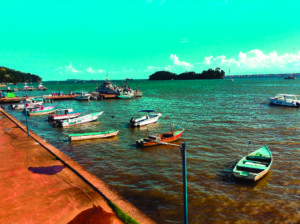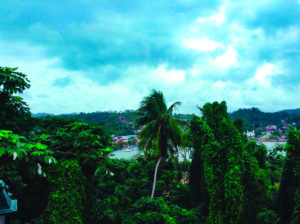Students Abroad
 The gleeful, unending screeching of the roosters woke me. Our first night in our second location otherwise went well, and our hosts have been extremely gracious. Myself and 11 other students are here in the Dominican Republic for two weeks to take part in a World Cultures class. We landed in the country on the Jan. 10, and we’ll be head home on Jan. 24. So far, at least, the trip has definitely been an adventure.
The gleeful, unending screeching of the roosters woke me. Our first night in our second location otherwise went well, and our hosts have been extremely gracious. Myself and 11 other students are here in the Dominican Republic for two weeks to take part in a World Cultures class. We landed in the country on the Jan. 10, and we’ll be head home on Jan. 24. So far, at least, the trip has definitely been an adventure.
We got lost in the jungle on our first night here. The driver got turned around, and by the time we figured out where in Samana we were staying, it was 4 a.m. Our group was split into two at our first location. The girls stayed with Dr. Frances Henderson, Associate Professor of Political Science, at a huge white house by the ocean, and the guys stayed with Dr. Doug Sofer, Associate Professor of History, at a French-Algerian expat’s place. Our first few days were pretty uneventful. We went shopping in town, where we tried to figure out how to bargain, and to the Malecon, where we learned that it’s completely safe to cross the bridge that warns against crossing in three separate languages.

It’s been interesting to start looking beneath the surface of Dominican culture. The Dominican Republic is a beautiful country–the ocean water is clear, the weather is warm and the mountains are more dramatic than anything in Tennessee. However, learning about the history of the country, and of the Caribbean more broadly, has been enlightening in a number of ways, though not always pleasant ones. During our first week here, we went to a military base by the sea that had been a disposal site for excess U.S. coal ash, a waste product that can lead to miscarriages, deformities and intellectual disabilities in children.
The disposal of coal ash at that site only stopped after U.S. environmentalists concerned over the long-term effects of coal ash on whales protested.
A few days ago, we went to the Los Haitises National Park, where we learned about the history of the island of Hispaniola prior to European arrival in 1492. At the park, which is made up of a series of caves located on a set of small islands an hour out from Samana, we learned about the history of the Taino. The Taino were indigenous people who made up most of the island’s population before Columbus set foot there. The group may have thought of the caves as sacred spaces, and in the present day, the Taino language survives in parts of the Dominican vocabulary.
In my experience, most Americans think of the Caribbean primarily as a tourist destination. Because of my own preconceptions, learning about its complicated history and dynamic politics has been eye-opening. On the Jan. 16, we went whale-watching and spent part of the afternoon on an island resort. It was a fun experience, but it was also kind of a purposefully-dissonant one. An important theme of the class has been the often-negative impact of the tourism industry on the Dominican Republic in a lot of instances, as the Caribbean’s dependence on tourism can be difficult for Dominicans since their economies are so reliant on the foreign tourist market. When the Caribbean has a bad hurricane season, or when the countries of tourists are having hard times economically, Caribbean jobs get cut, and, in places like the Dominican Republic where unemployment is already a huge issue, the results can be extremely devastating.
Additionally, as a history and political science major, learning about the complex and often violent relationship between the Dominican Republic and its neighbor to the west, Haiti, has also been interesting, though it is also often grim. During our trip, we’ll be going to Santiago to see a museum dedicated to the Mirabal sisters, who fought against the Dominican Republic’s longtime dictator, a prolific murderer of Haitians and Haitian-Dominicans, Rafael Trujillo.
We left our first lodgings yesterday; today, we’re starting a service project in the rural community of Pedro Garcia, in the mountains near Santiago, the second largest city in the Dominican Republic. It’s going to be interesting to discover another side of the Dominican Republic. Malicious roosters aside, my time in the Dominican Republic has been eventful and enlightening.

